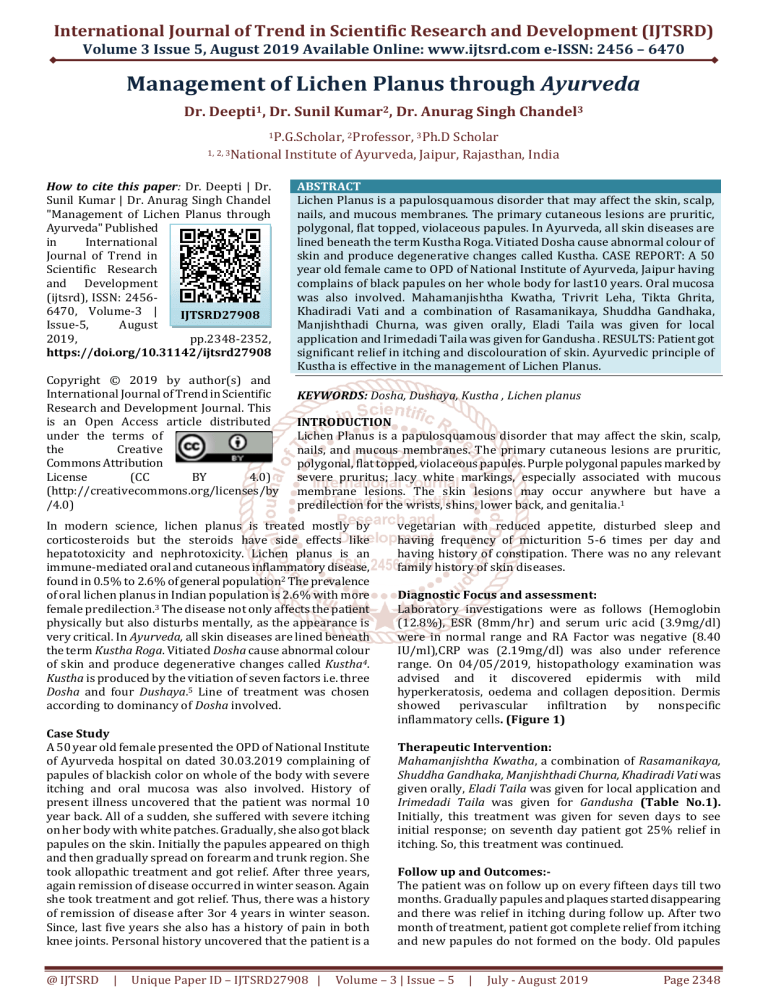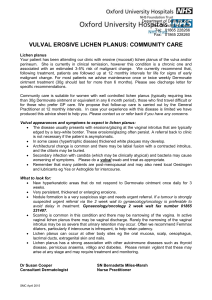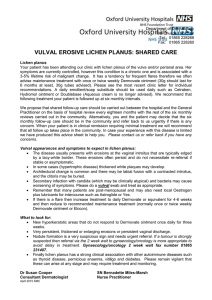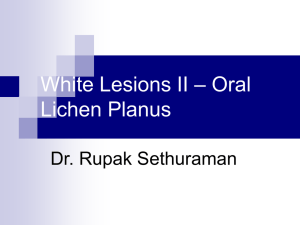
International Journal of Trend in Scientific Research and Development (IJTSRD) Volume 3 Issue 5, August 2019 Available Online: www.ijtsrd.com e-ISSN: 2456 – 6470 Management of Lichen Planus through Ayurveda Dr. Deepti1, Dr. Sunil Kumar2, Dr. Anurag Singh Chandel3 1P.G.Scholar, 2Professor, 3Ph.D Scholar 1, 2, 3National Institute of Ayurveda, Jaipur, Rajasthan, India How to cite this paper: Dr. Deepti | Dr. Sunil Kumar | Dr. Anurag Singh Chandel "Management of Lichen Planus through Ayurveda" Published in International Journal of Trend in Scientific Research and Development (ijtsrd), ISSN: 24566470, Volume-3 | IJTSRD27908 Issue-5, August 2019, pp.2348-2352, https://doi.org/10.31142/ijtsrd27908 Copyright © 2019 by author(s) and International Journal of Trend in Scientific Research and Development Journal. This is an Open Access article distributed under the terms of the Creative Commons Attribution License (CC BY 4.0) (http://creativecommons.org/licenses/by /4.0) ABSTRACT Lichen Planus is a papulosquamous disorder that may affect the skin, scalp, nails, and mucous membranes. The primary cutaneous lesions are pruritic, polygonal, flat topped, violaceous papules. In Ayurveda, all skin diseases are lined beneath the term Kustha Roga. Vitiated Dosha cause abnormal colour of skin and produce degenerative changes called Kustha. CASE REPORT: A 50 year old female came to OPD of National Institute of Ayurveda, Jaipur having complains of black papules on her whole body for last10 years. Oral mucosa was also involved. Mahamanjishtha Kwatha, Trivrit Leha, Tikta Ghrita, Khadiradi Vati and a combination of Rasamanikaya, Shuddha Gandhaka, Manjishthadi Churna, was given orally, Eladi Taila was given for local application and Irimedadi Taila was given for Gandusha . RESULTS: Patient got significant relief in itching and discolouration of skin. Ayurvedic principle of Kustha is effective in the management of Lichen Planus. KEYWORDS: Dosha, Dushaya, Kustha , Lichen planus INTRODUCTION Lichen Planus is a papulosquamous disorder that may affect the skin, scalp, nails, and mucous membranes. The primary cutaneous lesions are pruritic, polygonal, flat topped, violaceous papules. Purple polygonal papules marked by severe pruritus; lacy white markings, especially associated with mucous membrane lesions. The skin lesions may occur anywhere but have a predilection for the wrists, shins, lower back, and genitalia.1 In modern science, lichen planus is treated mostly by corticosteroids but the steroids have side effects like hepatotoxicity and nephrotoxicity. Lichen planus is an immune-mediated oral and cutaneous inflammatory disease, found in 0.5% to 2.6% of general population2 The prevalence of oral lichen planus in Indian population is 2.6% with more female predilection.3 The disease not only affects the patient physically but also disturbs mentally, as the appearance is very critical. In Ayurveda, all skin diseases are lined beneath the term Kustha Roga. Vitiated Dosha cause abnormal colour of skin and produce degenerative changes called Kustha4. Kustha is produced by the vitiation of seven factors i.e. three Dosha and four Dushaya.5 Line of treatment was chosen according to dominancy of Dosha involved. Case Study A 50 year old female presented the OPD of National Institute of Ayurveda hospital on dated 30.03.2019 complaining of papules of blackish color on whole of the body with severe itching and oral mucosa was also involved. History of present illness uncovered that the patient was normal 10 year back. All of a sudden, she suffered with severe itching on her body with white patches. Gradually, she also got black papules on the skin. Initially the papules appeared on thigh and then gradually spread on forearm and trunk region. She took allopathic treatment and got relief. After three years, again remission of disease occurred in winter season. Again she took treatment and got relief. Thus, there was a history of remission of disease after 3or 4 years in winter season. Since, last five years she also has a history of pain in both knee joints. Personal history uncovered that the patient is a @ IJTSRD | Unique Paper ID – IJTSRD27908 | vegetarian with reduced appetite, disturbed sleep and having frequency of micturition 5-6 times per day and having history of constipation. There was no any relevant family history of skin diseases. Diagnostic Focus and assessment: Laboratory investigations were as follows (Hemoglobin (12.8%), ESR (8mm/hr) and serum uric acid (3.9mg/dl) were in normal range and RA Factor was negative (8.40 IU/ml),CRP was (2.19mg/dl) was also under reference range. On 04/05/2019, histopathology examination was advised and it discovered epidermis with mild hyperkeratosis, oedema and collagen deposition. Dermis showed perivascular infiltration by nonspecific inflammatory cells. (Figure 1) Therapeutic Intervention: Mahamanjishtha Kwatha, a combination of Rasamanikaya, Shuddha Gandhaka, Manjishthadi Churna, Khadiradi Vati was given orally, Eladi Taila was given for local application and Irimedadi Taila was given for Gandusha (Table No.1). Initially, this treatment was given for seven days to see initial response; on seventh day patient got 25% relief in itching. So, this treatment was continued. Follow up and Outcomes:The patient was on follow up on every fifteen days till two months. Gradually papules and plaques started disappearing and there was relief in itching during follow up. After two month of treatment, patient got complete relief from itching and new papules do not formed on the body. Old papules Volume – 3 | Issue – 5 | July - August 2019 Page 2348 International Journal of Trend in Scientific Research and Development (IJTSRD) @ www.ijtsrd.com eISSN: 2456-6470 were slightly reduced and colour of papules also become faint. There is no reoccurrence of disease even after four months. (Table No.2) Discussion Diagnosis in this case was made on the basis of classical black to purple papules on thigh, forearm, wrists, ankle and oral mucosa accompanied with severe itching. In Ayurveda, all skin diseases are lined beneath the term Kustha Roga. Vitiated Dosha cause abnormal colour of skin and produce degenerative changes called Kustha. Kustha is produced by the vitiation of seven factors i.e. three Dosha and four Dushaya. Due to Ahitakara Nidana Sevana, first these three Dosha Vata, Pitta and Kapha get vitiated and that they additionally vitiate Twak, Rakta, Lasika and Mamsa. .Aacharya Charaka while describing Kustha treatment very firstly has mentioned that all Kustha are Tridoshaja in nature and should be treated according to dominancy of Dosha. First treat the dominant Dosha then rest of the vitiated Dosha should be treated6. Patient was treated on the principle of management of Kushtha Roga. In the present case patient had symptoms of mainly vitiated Kapha Dosha i.e. severe itching, hyperkeratosis on whole of the body associated with symptoms of Vitiated Vata Dosha (Karshnyata). So, we advised drug according to dominancy of Dosha involved. some of these drug were Kusthahara (Rasamanikaya, Manjishthaadi Kshaya, Panchtikta Ghrita, eladi Taila), Raktaprasadak( Manjishthadi Churna), Kaphashamaka (Rasamanikaya, , Manjishthaadi Kshaya,Eladi Taila), Vatashamaka(Rasamanikaya, Panchtikta Ghrita, Eladi Taila), Trivrit leha is Mridu Virechaka ,it is used for Nitya Shodhana and because oral mucosa was also involve; so, Khadiradi Vati and Irimedadi Taila was also advised for Gandusha(Gargles) because both of these drug are drug of choice of treatment in Mukha Roga(Table No.3). By this treatment, vitiated Dosha comes in balance state and symptoms of vitiated Dosha subside gradually. And patient got significant relief. Conclusion Lichen Planus is an autoimmune disease involving skin and oral mucosa; it is notorious for its reoccurrence. Treatment options of conventional system of medicine in lichen planus have very side effects. Line of treatment of Kustha is safe and effective in Lichen Planus symptomatically. References [1] Tinsley R. Harrison. Harrison’s Principles of Internal Medicine. 16th edition Mcgrew hill medical publishing division p.349 [2] Kanemitsu S. Oral lichen planus: malignant potential and diagnosis. Oral Sci Int. 2014; 11:1–7. doi: 10.1016/S1348-8643(13)00030-X. [3] Murti PR, Daftary DK, Bhonsle RB, Gupta PC, Mehta FS, Pindborg JJ. Malignant potential of oral lichen planus: observations in 722 patients from India. J Oral Pathol. 1986; 15:71–7. doi: 10.1111/j.16000714.1986.tb00580.x [4] Kaviraj Atridev Gupt:2012 Astangahrdayam Nidana Sthana; Kustha shwitra krimi Nidana chapter14 verse3; Chaukhambha Prakashana; Varanasi, india p. 369 [5] Pandit KashinathShastri & Dr. GaurakhnathChaturvedi: 2011CarakaSamhita, ChikitsaSthana; KusthaChikitsa; Chapter 7; verse 9-10Chaukhambha Bharati Academy, Varanasi, india, p. 248 [6] Pandit KashinathShastri & Dr. Gaurakhnath Chaturvedi2011 CarakaSamhita, ChikitsaSthana; KusthaChikitsa; Chapter 7; verse 31-32 Chaukhambha Bharati Academy, Varanasi, indiap. 253 [7] Ayurved Sara Sangraha2016, Shri Baidyanath Ayurved Bhawan limited naini Allahabad, india, p. 445 [8] Ayurved Sara Sangraha2016, Shri Baidyanath Ayurved Bhawan limited naini Allahabad, india, p. 770 [9] Ayurved Sara Sangraha2016, Shri Baidyanath Ayurved Bhawan limitednaini Allahabad, india, p. 683 [10] Ayurved Sara Sangraha2016, Shri Baidyanath Ayurved Bhawan limited naini Allahabad, india, p. 813 [11] Ayurved Sara Sangraha2016, Shri Baidyanath Ayurved Bhawan limited naini Allahabad, india, p. 797 [12] Ayurved Sara Sangraha2016, Shri Baidyanath Ayurved Bhawan limited naini Allahabad, india, p. 876 [13] Ayurved Sara Sangraha2016, Shri Baidyanath Ayurved Bhawan limited naini Allahabad, india, p. 990 [14] Ayurved Sara Sangraha2016, Shri Baidyanath Ayurved Bhawan limited naini Allahabad, india, p. 567 Table No. 1 showing days and dosage of Shaman treatment Name of the Drug used Dose Rasamanikaya+Shuddha Gandhaka+Manjishthadi Churna Panchtikta Ghrita Manjishthadi Kasaya Khadiradi Vati Trivrit Leha Eladi Taila Irimedadi Taila 125mg+250mg+5gm twice a day 10 ml twice a day 20 ml twice a day 6 tablet in a day 5gm twice a day 10 ml Route of administration Oral Oral Oral Oral Oral Local application Oral (Gandushartha) Table No.2: Improvement in complaints of Lichen planus patient after Shaman chikitsa Symptoms Before treatment After one month of treatment After two month of treatment Papule size 2-3 mm Same Slightly reduced Colour Dark black Slightly faint Slightly faint Itching ++++++ +++ + New papule formation 2-3 per week Nil Nil @ IJTSRD | Unique Paper ID – IJTSRD27908 | Volume – 3 | Issue – 5 | July - August 2019 Page 2349 International Journal of Trend in Scientific Research and Development (IJTSRD) @ www.ijtsrd.com eISSN: 2456-6470 Table No.3 showing ingredients, properties and action of the drugs given. Drug Ingredients Properties and action VataKaphashamaka, useful in skin disease like Kustha, Visharpa, Vipadika, Vicharchika Ushna, Tikshna, Vyavayi, Vikasi, Katu , Tikta Rasa and Katu Vipaka, useful in Kustha, Vattapittakapha Vikara, Dustha Rakta Vikara. Rasamanikaya7 Hartala(Arsenic Sulphde) Panchatikta Ghrita8 Neem(Azadirachta indica), Patola(Trichosanthes dioica), Kateri(Solanum indicum),Vasa(Adhatoda vasica), Giloya(Tinospora cordifolia), Amalaki(Emblica officinalis), Haritaki(Terminalia chebula) and Baheda(Terminalia bellirica),Goghrita(cow ghee) Manjishthadi Churna9 Manjishtha(Rubia Cordifolia), Choti elaichi( Elettaria cardamomum), Saunf(Foeniculum Vulgare), Saunageru(Red Ochre), Pashanbheda(Bergenia Ligulata), Sanaya(Cassia Angustifolia) Manjishthadi Kasaya10 Khadiradi Vati11 Trivrit Leha12 @ IJTSRD | Manjishta(Rubia cordifolia),Musta (Cyperus rotundus),Kutaja(Holarrhena antidysenterica), Guduchi(Tinospora cordifolia), Kushta(Saussurea lappa),Nagara (ginger), Bharngi(Clerodendron serratum), Kshudra(Solanum xanthocarpum), Vacha(Acorus calamus), Nimba (Azadirachta indica) ,Haridra(Turmeric), Daruharidra( Berberisaristata), Haritaki(Terminalia chebula), Vibhitaki (Terminalia bellirica),Amla (Emblica officinalis), Patola (Luffa acutangula) ,Katuka(Picrorrhiza kurroa), Murva (Marsdenia tenacissima),Vidanga(Embelia ribes),Asana(Pterocarpus marsupium), Chitraka (Plumbago zeylanica), Shatavari (Asparagus racemosus),Trayamana(Gentiana kurroo) Krishna(Long pepper),Indrayava (Holarrhena antidysenterica),Vasa(Adhatoda vasica)Bhringaraja (Eclipta alba), Mahadaru (Cedrus deodara), Patha(Cissampelos pariera), Khadira(Acacia catechu),Chandana(Santalumalbum),Trivrit(Operculina turpethum),Varuna(Crataeva nurvala), Kiratatikta (Swertia chirata), Bakuchi (Psoralea corylifolia), Kritamala (Cassia fistula),Shakhotaka(Streblus asper), Mahanimba(Melia azadirachata), Karanja(Pongamia pinnata), Ativisha(Aconitum heterophyllum), Jala(Pavonia odorata), Indravaruni (Citrullus cholocynthis),Ananta(Hemidesmus indicus),Sariva (Hemidesmus indicus),Parpata (Fumaria indica) Khadira (Acacia catechu),Arimeda( Acacia leucophloea /farnesiana ),Chandana(Santalum album),Padmaka (Prunus puddum/ cerasoides), Usheera(Vetiveria zizanioides),Manjishta (Rubia cordifolia), Dhataki (Woodfordia fruticosa),Ghana (Cyperus rotundus),Prapaundarika(Nymphaea stellata),Yashti (Glycyrrhizaglabra), Twak (Cinnamomum zeylanicum), Ela(Elettaria cardamomum), Padma (Nelumbium speciosum), Nagakeshara (Mesua ferrea), Laksha(Laccifer lacca),Rasanjana – Aqueous extract of Berberis aristata, Mamsi(Nardostachys jatamansi),Haritaki (Terminalia chebula),Vibhitaki (Terminalia bellirica),Amalaki (Emblica officinalis / Phyllanthus emblica),Lodhra (Symplocos racemosa), Balaka(Pavonia odorata),Haridra (Curcuma Longa),Daruharidra (Berberis aristata),Phalini (Callicarpa macrophylla),Ela(Elettaria cardamomum),Samanga Rubia cordifolia), katphala(Myrica nagi), Vacha(Acorus calamus), Yavasa(Fagonia cretica/Arabica), Agaru(Aquilaria agallocha), Pattanga(Caesalpinia sappan), Gairika(Purified red ochre),Anjana – Aqueous extract of Berberis aristata),Lavanga (Syzigium aromaticum),Nakha (Capparis zeylanica), Kankola(Piper cubeba),Jatikosha (Myristica fragrans), Karpoora (Cinnamomum camphora) Trivrit (Operculina turpethum) Unique Paper ID – IJTSRD27908 | Raktashodhaka,Pittashamaka KaphapittaVikara and Kusthahara Effective in Mukha Roga Virechaka Volume – 3 | Issue – 5 | July - August 2019 Page 2350 International Journal of Trend in Scientific Research and Development (IJTSRD) @ www.ijtsrd.com eISSN: 2456-6470 Irimedadi Taila13 Eladi Taila14 @ IJTSRD | Yashti (Glycyrhiza glabra),Trijatha (Cinnamon, cardamom and Cinnamomum tamala),Manjishta (Rubia cordifolia), Gayatri (Acacia catechu),Lodhra (Symplocos racemosa),Katphala (Myrica nagi), Irimeda Twak (Acacia leucophloea /farnesiana), Musta (Cyperus rotundus),Agaru (Aquilaria agallocha),Shveta Chandana (Santalum album),Rakta Chandana (Pterocarpus santalinus),Karpoora ( Cinnamomum camphora), Jati (Myristica fragrans),Takkola (Illicium verum),Mamsi (Nardostachys jatamansi),Dhataki (Woodfordia fruticosa),Gairika (Red ochre),Mrinala (Cymbopogon jwarancusa),Mishi (Anethum sowa), Vaidehi (Piper longum), Padmakesara(Nelumbo nucifera), Kumkuma (Crocus sativus), Laksha (Laccifer lacca), Manjishta(Rubia cordifolia),Brihati (Solanum indicum), Bilvapatra(Aegle marmelos), Suradruma – Cedrus deodara), Shaileya (Asphaltum), Sarala( Pinus roxburghi), Sprikka (Frlphinium zalil), Palasha – Butea monosperma),Rajani(Curcuma longa), Daruharidra (Berberis aristata), Priyangu (Callicarpa macrophylla), Tejani (Clematis triloba), Pradhakaleya (Coscinium fenestratum), Pushkara ( Inula raceomsa), Jaya(butilon theophrasti), Vyaghri(Solanum xanthocarpum), Madana(Randia dumetorum), Tila TailaSesame oil(Sesamum indicum), Arimeda(Acacia leucophloea), Nyagrodha(Ficus bengalensis), Udumbara ( Ficus racemosa), Ashwattha (Ficus religiosa), Plaksha( Ficus lacor Tila taila (Oil of Sesamum indicum), Ela (Elettaria cardamomum),Sthoola Ela (Amomum subulatum), Turushka (Hydnocarpus laurifolia), Kushta (Saussurea lappa), Phalini(Callicarpa macrophylla), Mamsi (Nardostachys jatamansi), Jaladhyamaka (Coleus zeylanicus) ,Sprikka(Anisomeles malabarica), Choraka (Angelica archagelica), Chochapatra (Cinnamomum zeylanicum), Tagara(Valeriana wallichii), Sthauneya – Taxus baccata, Jati( (Myristica fragrans) , Rasa( Commiphora myrrha), Shukti(Ostrea edulis), Vyaghranakha ( Capparis sepiaria), Marahva (Cedrus deodara), Aguru (Aquilaria agallocha), Shrivasaka (Pinus longifolia), Kumkuma (Crocus sativus),Chanda (Costus speciosus),Guggulu (Commiphora mukul),Devadhupa (Shorea robusta),Khapura (Boswellia serrata),Punnaga (Calophyllum inophyllum),Nagahva – Mesua ferrea Unique Paper ID – IJTSRD27908 | Volume – 3 | Issue – 5 | Effective in all Mukha Roga VataKaphashamaka, Varnaprasadana, Kandu,Pitika,Kothanashak July - August 2019 Page 2351 International Journal of Trend in Scientific Research and Development (IJTSRD) @ www.ijtsrd.com eISSN: 2456-6470 Before treatment:- After treatment:- @ IJTSRD | Unique Paper ID – IJTSRD27908 | Volume – 3 | Issue – 5 | July - August 2019 Page 2352




